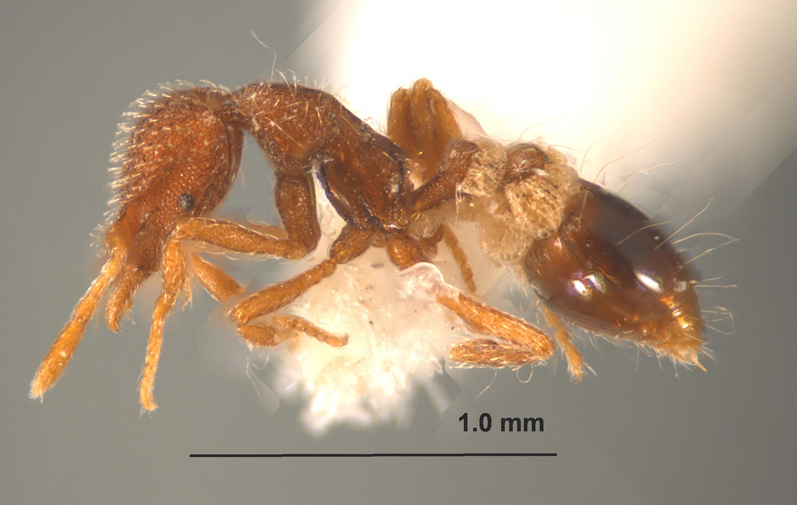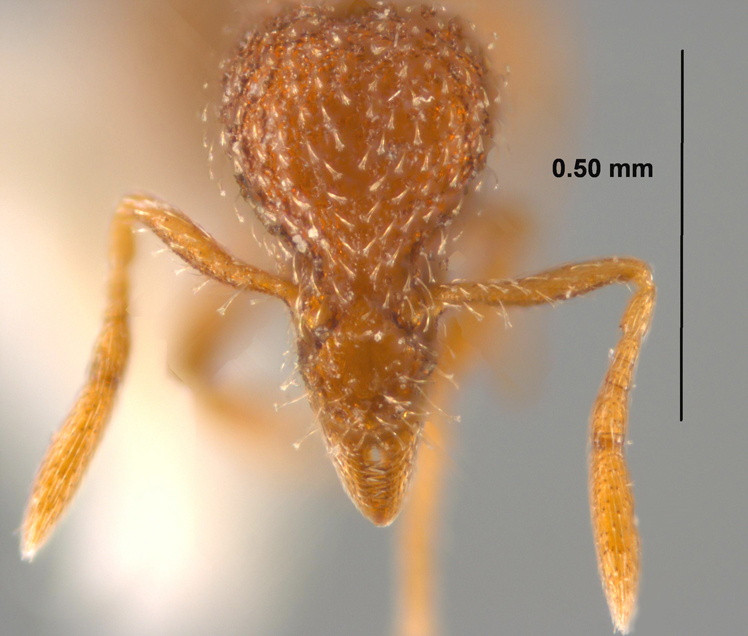Subfamily MYRMICINAE by Joe A. MacGown, updated on 19 November 2013 |
Strumigenys bimarginata, full face view of worker (click to enlarge). |
 |
Strumigenys bimarginata, profile view of worker. |
Introduction Strumigenys bimarginata is a rarely collected species in the clypeata group. Based on label data, this species may be associated with grasslands. Taxonomic History (provided by Barry Bolton, 2013)
Identification
TL 2.2–2.4, HL 0.58–0.61, HW 0.34–0.36, CI 62–65, ML 0.10, SL 0.27–0.29, PW 0.23–0.25, WL 0.52–0.55 (measurements and description from Bolton (2000)).Mandibles triangular, serially dentate from clypeal border; with a triangular basal lamella, then dentition of principal tooth row with 5 sharp triangular teeth, of which tooth 3 is the longest, then two small teeth, four denticles, and a small apical tooth. Leading edge of scape with setae that all curve toward apex of scape. In profile, the edge of the clypeus has a distinct dorsal border with a more strongly prominent ventral border, the two borders separated by the evenly concave peripheral groove, and both borders are visible and concentric in full face view as the lower border projects beyond the upper border. Spongiform appendages well developed on dorsum and ventral portions of petiole and postpetiole; first gastral tergite with narrow band of weak spongiform tissue present basally. Setae on anterior and lateral clypeal margins long and fine, flattened, splayed, o weakly forked apically, and may curve slightly away from midline. Clypeal dorsum with setae semi-erect to erect, short and curved, flattened, splayed, or forked apically, with some setae curving posteriorly. Ground pilosity of head narrowly spatulate with flattened and splayed apices, curved anteriorly to weakly anteromedially. Flagellate setae absent on head; one pair of flagellate setae on pronotal humerus, on pair on pronotal dorsum, pair on mesonotum, single flagellate seta on hind basitarsus, and numerous ones on first gaster tergite. Clypeal dorsum smooth, dorsum of head behind clypeus reticulate-punctate; pleurae, side of propodeum, and postpetiole disc smooth, remainder of mesosoma and petiole disc with reticulate-punctate sculpture; first gastral tergite with striae basally, then becoming smooth. Strumigenys bimarginata is most similar to S. filirrhina from which it differs by lacking elongate, flagellate setae on head and by its ground pilosity being flattened, split and/or splayed at apices of setae. Biology and Economic Importance Distribution Literature Cited Bolton, B. 1999. Ant genera of the tribe Dacetonini (Hymenoptera: Formicidae). Jour. Nat. Hist. 33: 1639-1689. Bolton, B. 2000. The ant tribe Dacetini. Mem. American Entomol. Inst. 65:1-1028. Bolton, B. 2013. Bolton World Catalog Ants. Available online: http://www.antweb.org/world.jsp. Accessed 16 April 2013. Brown, W. L., Jr. 1953. Revisionary studies in the ant tribe Dacetini. Am. Midl. Nat. 50: 1-137 Creighton, W. S. 1950a. The ants of North America. Bulletin of the Museum of Comparative Zoology 104:1-585. Smith, M. R. 1947. A generic and subgeneric synopsis of the United States ants, based on the workers. American Midland Naturalist 37:521-647. Smith, M. R. 1951. Family Formicidae. Pp. 778-875 in: Muesebeck, C. F.; Krombein, K. V.; Townes, H. K. (eds.) 1951. Hymenoptera of America north of Mexico. Synoptic catalogue. United States Department of Agriculture. Agriculture Monograph 2:1-1420. Wesson, L. G.; Wesson, R. G. 1939. Notes on Strumigenys from southern Ohio, with descriptions of six new species. Psyche (Cambridge) 46:91-112. |



